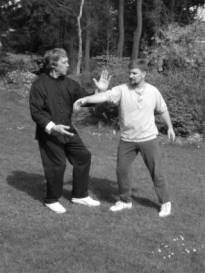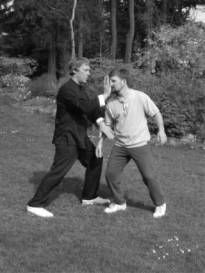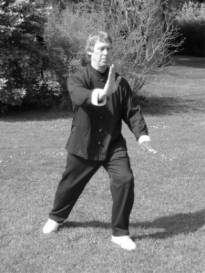 Gilman Studio On-Line Lessons
Gilman Studio On-Line Lessons
Yang Style Long Form
Tai Chi Chuan
This Lesson Contains:
Yin and Yang of Tai Chi Chuan
Movement # 12 – Left Brush Knee
Yin and Yang
The study of Tai Chi Chuan is the study of Yin and Yang — how they relate, engage and disengage, in a never ending cycle. Every facet of our Tai Chi practice, and our life also, can be viewed through the Yin/ Yang perspective. It is important to remember that nothing is absolute. Yin contains Yang and vice versa, just as night contains day, up contains down, etc. Also, these two energies balance each other out. The Chinese have classified everything into Yin and Yang and their whole system of natural medicine is based on Yin and Yang theory. If something gets too Yin, add Yang. Let’s look at how this theory relates to Tai Chi.
Tai Chi — Yang Side
Yang is given the attributes of male, hot, dry, expanding or outward and upward moving, hard, aggressive, positive, etc. If we think about Tai Chi, we can see that movements that use a fist (the most Yang part of the body), that push, pull, strike, kick, ward off, all can be considered Yang.
Tai Chi — Yin side
Yin is given the attributes of female, cool, moist, contracting or inward and downward moving, soft, yielding, negative, etc. Yin movements use open hand (the most Yin part of the body), yield, deflect, parry, move in toward the body, and usually downward.
It is important to remember that Yin contains Yang and Yang contains Yin. Every movement of Tai Chi is a combination of these two energies, with one being more predominate. Also remember that Yin balances out Yang and vice versa. If you look at the most basic movement, Ward Off, ( Lesson # 3), you’ll get the idea.
The opponent pushes or punches to our center. This is a Yang movement on his part. We need to balance or neutralize this energy with Yin. In this case, we join his energy with the right hand (open and Yin ) and lead it to the right side and slightly downward (Yin). At this point his Yang is neutralized and starts to turn into Yin ( he starts to retreat back into his center for balance and stability). We then must change to Yang so we follow him forward and attack his center with the left forearm ( Yang in that it moves out and up in an expanding nature).
Each movement of Tai Chi contains a movement from Yin to Yang or Yang to Yin in order to first neutralize the opponent’s energy and then follow up with energy of our own. If the opponent uses Yin, I use Yang. When he Rolls Back, I Press. If he uses Yang, I use Yin. He kicks and I Retreat to Ride A Tiger. If he attacks my right side (Yang ), I empty the right (Yin ) and fill the left (Yang). When two people who are good at playing Tai Chi push hands get together, it is like a fine balance scale in that the slightest addition to one side must be met with an equal addition to the other side in order to maintain equilibrium. The master of Tai Chi will be so subtle in his or her addition or subtraction of energy that the partner will not know what is happening until it is too late to make a change. The Tai Chi Classics say “ I know my opponent and he doesn’t know me.”
So meditate on the idea of Yin and Yang and see if your form doesn’t markedly improve.
Movement# 12 – Left Brush Knee
As I said in Lesson # 11, Brush Knee is an important movement in Tai Chi Chuan. Here we have the first repeat. It is quite similar to the previous one, only we are staring from a different place. For this application rex is pushing toward my center. I neutralize it to the right, step to his closed up side (my left) and strike him with my palm. For a complete discussion of opening and closing the opponent, see my article in Tai Chi Magazine, Volume 24, No.4, and entitled Principles for Clarifying Intention. This back issue can be ordered from Tai Chi magazine at www.tai-chi.com.

 Following Play the Fiddle, I pull my left foot into Ding Bow on Toe. This is done to get it out of the easy reach of the opponent and also make it available to kick, block, or step. At the same time the torso turns slightly to the right and the left arm moves to the right with the palm facing in that direction. The right hand has relaxed down by the right hip with the palm facing upward.
Following Play the Fiddle, I pull my left foot into Ding Bow on Toe. This is done to get it out of the easy reach of the opponent and also make it available to kick, block, or step. At the same time the torso turns slightly to the right and the left arm moves to the right with the palm facing in that direction. The right hand has relaxed down by the right hip with the palm facing upward.
All of this allows me to neutralize the incoming energy to the right and stick to it with my left forearm. Make sure the body is turning to the right to bring over the left arm.
Focus on the left forearm for sticking.

 Step to the left with the heel (the same as movement #11) and then shift the weight onto the left foot. Turn the torso to the left as you shift the weight, ending up facing slightly to the left of west.
Step to the left with the heel (the same as movement #11) and then shift the weight onto the left foot. Turn the torso to the left as you shift the weight, ending up facing slightly to the left of west.
The left arm has pressed partner’s arm down and out of the way (brushing the knee) and the right hand has extended outward to end up on the right side of the center of the chest.
First focus on the left forearm for brushing, then on the left palm for striking.
 Notice that all the pieces are in alignment according to the principles we have discussed. The left knee just covers the toe; the knee is facing the direction the toe is headed. The rear foot is at a 45-degree angle to the direction the left toe is headed. The rear (right) leg is fairly straight with a bit of flex at the knee. The shoulders and elbows are drooped downward with flex at the joint. There is balance between the outward pushing right palm and the downward and backward pull of the left hand. The back is straight without being stiff. There is a strong line of energy from the rear foot up to the right palm. The body is full of Peng Jin like an inflated tire. The focus is in the left palm.
Notice that all the pieces are in alignment according to the principles we have discussed. The left knee just covers the toe; the knee is facing the direction the toe is headed. The rear foot is at a 45-degree angle to the direction the left toe is headed. The rear (right) leg is fairly straight with a bit of flex at the knee. The shoulders and elbows are drooped downward with flex at the joint. There is balance between the outward pushing right palm and the downward and backward pull of the left hand. The back is straight without being stiff. There is a strong line of energy from the rear foot up to the right palm. The body is full of Peng Jin like an inflated tire. The focus is in the left palm.
